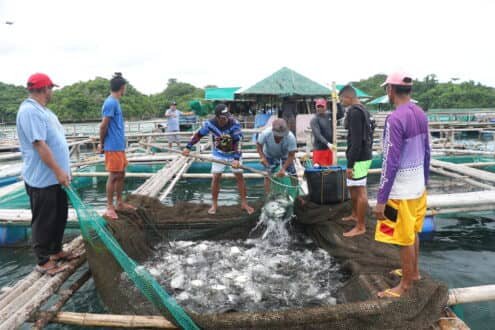By Celeste Anna Formoso
Palawan, The Philippines.- A Southeast Asian Fisheries Development Center (SEAFDEC) expert said milkfish (bangus) production in Palawan is low despite the province having potential brackish water ponds that could help develop the industry.
Dr. Evelyn Grace de Jesus-Ayson of SEAFDEC said Thursday that the low production of milkfish can actually be helped by mariculture.
Mariculture is a branch of aquaculture that cultivates fish and other products for food in the open sea, which the province can try in the farming of “bangus”.
“Maraming areas na brackish water ponds na puwedeng either i-develop or redevelop para ma-improve ‘yong production ng bangus (There are many brackish water ponds that can either be developed and redeveloped for the production of bangus),” Ayson said.
She said fish cages can be set up in coves to increase the production of “bangus” and build for it a solid industry. One of the advantages of the cage culture, she added, is its “stocking density” that can be achieved.
“Kung meron kang 10x10x4-meter deep kunwari na cage pwede kang mag-stock ng up to 15,000 fish per cage and ‘yung isang cage mo ay makaka-produce ng seven tons. So way higher than the production sa brackish water ponds (If you have a 10x10x4-meter deep cage, you can stock up 15,000 fish per cage, and one cage can produce seven tons. This is way higher than the production in brackish water ponds),” Ayson said.
Stay Always Informed
Join our communities to instantly receive the most important news, reports, and analysis from the aquaculture industry.
She said “bangus” from cages tastes even better because of the salt present in seawater.
If hatchery and feed production facilities are improved in Palawan, they can help in developing the aquaculture industry fast, she added.
Based on records of the Philippine Statistics Authority, the production of “bangus” in the province went down to 4,000 metric tons in 2017 from 10,000 metric tons in 2014-2016.
Ayson was one of the speakers invited to speak to 40 milkfish farmers, who participated in the aquaculture training on November 27-29 that was spearheaded by the Office of the Provincial Agriculturist – in partnership with the Department of Agriculture’s Agricultural Training Institute.
Source: PNA
Editor at the digital magazine AquaHoy. He holds a degree in Aquaculture Biology from the National University of Santa (UNS) and a Master’s degree in Science and Innovation Management from the Polytechnic University of Valencia, with postgraduate diplomas in Business Innovation and Innovation Management. He possesses extensive experience in the aquaculture and fisheries sector, having led the Fisheries Innovation Unit of the National Program for Innovation in Fisheries and Aquaculture (PNIPA). He has served as a senior consultant in technology watch, an innovation project formulator and advisor, and a lecturer at UNS. He is a member of the Peruvian College of Biologists and was recognized by the World Aquaculture Society (WAS) in 2016 for his contribution to aquaculture.




